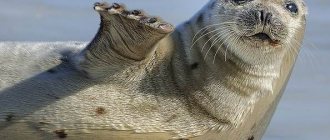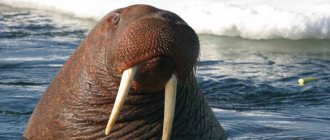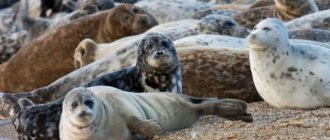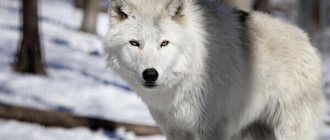Seals live in different regions, but they are practically the same in appearance. The Eastern and Pacific varieties are typically slightly larger than their Western Atlantic counterparts. The seal population today is estimated to be around 500,000. The common seal is common in the seas adjacent to the waters of the Arctic Ocean. The Baltic European subspecies lives along the coast of the Baltic Sea, and the Barents Sea subspecies is found in the waters of the northern coasts of Murman. The Russian Kuril subspecies is an inhabitant of the Lesser Kuril ridge and the islands of the Greater Kuril ridge. Seals usually choose rocky areas to live in, where they can easily hide from attacks by predators. This species avoids open sea spaces and hides in bays and river mouths.
Description of the common seal
The common seal has a body length of up to 1.85 m, its weight reaches 160 kg. Males are usually slightly larger in size than females; they have no other external differences. A characteristic feature of harbor seals is their V-shaped nostrils. From them it is very easy to recognize the animal, no matter what color its skin is. The coloring of seals is very diverse. It contains shades of brown, gray and red. The predominant color is reddish-gray. Small spots of brown or black color, similar to oblong strokes, are noticeable throughout the body. The back is sometimes decorated with patterns of black-brown spots. Seals often have black spots on their muzzle, head and tail. The color of newborn babies is always exactly the same as that of their parents. The common seal is not characterized by white fur in the first months of life, as is the case with its close relatives. The head is ovoid. The muzzle is short. The eyes are large, expressive, dark in color. The front legs are short, the hind legs are much better developed, they are strong and strong. The tail is short, the jaws are well developed, the teeth are large and strong, and there are large fangs. The common seal moves nimbly across the surface of the earth and ice, despite its heavy weight and the fact that it appears rather clumsy in appearance.
Distribution of the harbor seal
The common seal is distributed in the east and west of the Arctic Ocean. The eastern regions include the waters of the Bering Sea, the Chukchi Sea and the Beaufort Sea. In the west, these are the waters of the Barents Sea and the southern coast of Greenland. The species is also found in other Arctic seas, but rarely. The common seal also lives in the northern coastal waters of the Atlantic and Pacific Oceans, and permanently lives in the Baltic Sea. The common seal prefers coastal waters to live and does not travel far. At the end of summer and autumn, it establishes rookeries on spits and shallows where the tides ebb and flow. It does not settle in open areas and wide banks. Can swim and dive well.
Origin of Species: A Controversial Issue
The version of the different origins of seals has its opponents. Thus, some scientists argue that pinnipeds appeared approximately fifty million years ago, when neither the mustelidae family nor the bear family existed. Such researchers are inclined to assume that both true and eared seals nevertheless descended from a common ancestor, belong to the family of pinnipeds and are included in the suborder of dog-like arctoid predators, which, in addition to them, also included raccoons, canines, mustelids and bears.
Common subspecies of the harbor seal
For one species of seal, five subspecies are known according to their main habitat regions:
- Western Atlantic seal (Phoca vitulina concolor), distributed in the eastern waters of North America;
- The Ungava seal (Phoca vitulina mellonae) lives in fresh waters in eastern Canada.
— Advertising —
- The Pacific harbor seal (Phoca vitulina richardsi) lives in the western waters of North America;
- The island seal (Phoca vitulina stejnegeri) is found in eastern Asia;
- East Atlantic seal (Phoca vitulina vitulina). The most common subspecies, found in waters around Europe and Western Asia.
Lifestyle
Most seals live in coastal areas - where underwater currents raise masses of water from the bottom, teeming with microscopic creatures. There is a lot of small aquatic fauna in these places. This, in turn, is eaten by fish, which serve as food for seals.
This is a carnivore. The seal has a tooth structure similar to that of carnivorous mammals. He prefers to hunt by diving into the depths. In addition to fish, seals feed on crayfish, crabs, and cephalopods. The leopard seal sometimes attacks penguins and other smaller seals.
These creatures are perfectly adapted to low temperatures. They lead a predominantly aquatic lifestyle, coming to land to sleep and during periods of molting and reproduction. When a seal dives, its nostrils and ear holes close tightly, preventing water from entering. Most seals have poor vision, but their eyes are adapted to observe movement in the water in low light conditions.
Common seal behavior
Seals do not travel long distances and usually stick to stable habitats. To live, they form herds, the size of which depends on the time of year and place of residence. It moves along the surface of the earth by crawling, since it cannot rely on its hind legs, which are converted into flippers. But the seal swims and dives very well. Can stay under water for 45 minutes.
Features of character and lifestyle
Photo: Great eared seal
Seals lead a quiet lifestyle. Eared seals spend most of their time in the water, where they hunt and sometimes even sleep. Seals sleep in the water with their flippers spread out; the seal floats on the surface of the water thanks to subcutaneous fat. Sometimes a seal can sleep at a depth of several meters for a time, surfacing from time to time, taking a couple of breaths and diving back. In this case, the animal does not even wake up. Seals are calm and peaceful animals. Due to their enormous size, walruses have virtually no enemies or competitors and have nothing to worry about.
During the breeding and molting season, seals come ashore. Unlike walruses, eared seals avoid ice and build their rookeries on the banks. Seals are active both during the day and at night. Eared seals are herd polygamous animals. They take good care of their offspring and are able to act together with other seals. Before the breeding season, males divide the territory and protect it from the penetration of strangers into this territory. Eared seals are almost always calm, and show aggression only when there are threats of attack on them or their cubs.
In relation to humans, eared seals are relatively safe. Seals do not attack people; there are even known cases of seals stealing slaves on ships, without touching or touching people. However, this huge animal can touch or crush a person or an animal nearby. Some species of fur seals and seals are trainable and get along well with people.
Reproduction of the common seal
Pregnancy in a common seal lasts 11 months. At the end of May or beginning of June, during low tide, births occur on the shallows, usually one baby is born. Its body length is about 1 meter, weight is approximately 13 kg. After just a few hours, the tide comes in, and the newborn seal immediately swims after its mother. This is due to the fact that the baby sheds its fur while still in the womb, and is born in the so-called “bathing suit”. The milk feeding period lasts about a month. Then the female becomes pregnant again, mating games and mating in seals take place in the water. Immediately then comes the time of molting. This process is quite painful for the common seal; the animals endure it in rookeries. Seal rookeries are located on rocky islands and reefs that stick out of the water and are least accessible to predators. Seals that live in Arctic waters mate, give birth to pups, and moult right on the ice floes. In general, their lifestyle is the same as that of other subspecies. Female harbor seals usually become sexually mature at the age of 3-4 years. In males, this process is completed a little later, at 5-6 years. The life expectancy of females reaches 35-40 years, they give birth until about the age of 28 years. Males live less, about 25 years.
Internal structure
Seals are chordates and have a well-developed spine. The entire skeleton is developed, there are clavicles and shoulder blades, several pairs of ribs.
The internal structure has some features:
- The respiratory system is represented by the airways and paired lungs. Air enters them, oxygen particles are transferred with the bloodstream to organs and tissues.
- The circulatory system is closed, there is a systemic and pulmonary circulation. The heart has four chambers, all chambers are separated from each other by septa and valves. Arteries and veins branch off from the organ. Arterial blood carries oxygen, venous blood carries carbon dioxide.
- The nervous system is represented by the brain and spinal cord. Sensitive and motor nerve endings depart from the second. The cerebral hemispheres are quite well developed, and there is also a cerebellum.
- The digestive system begins with the mouth, which contains teeth for grinding food and a tongue for easier swallowing. The esophagus smoothly passes into the stomach. Seals have a rather long intestine ending in an anus. In addition, for better digestion, the pancreas and liver secrete enzymes.
- The excretory system is represented by the kidneys, the ureters from which open into the bladder.
The reproductive system of seals is represented by paired gonads, which are located in the lower part of the abdominal cavity.
Males do not have a scrotum; females have 1 to 2 pairs of nipples. Like other mammals, seals are viviparous; the pups are small at birth, but can be large, depending on the species.
Natural enemies of the common seal
Common seals are hunted by polar bears, but the seal's caution and foresight makes it difficult prey for this predator. Killer whales do a lot of harm to seals. This powerful predator easily catches and eats seals. The animal can only escape if it manages to get ashore, but given the power and speed of the killer whale, this is usually quite difficult to do.
Interesting facts about the harbor seal:
- There is a monument to a seal in Arkhangelsk. This is due to the fact that it was this animal that saved thousands of city residents, as well as besieged Leningrad, from starvation during the Great Patriotic War.
- Two subspecies of seals live in the waters of Russian waters: Kuril (Stanger seal) and European. Both subspecies are listed in the Red Book. The status of populations of various subspecies also varies greatly, some of them are rarer, others have survived in greater numbers today. Long-term fishing has had a negative impact on seal numbers. In addition, harmful industrial wastes cause great harm to animals: emissions of oil, cadmium, and mercury into the seas and oceans. Many young seals die from streptococcal infections. For these reasons, harbor seals currently require conservation and protection to prevent further population decline.











